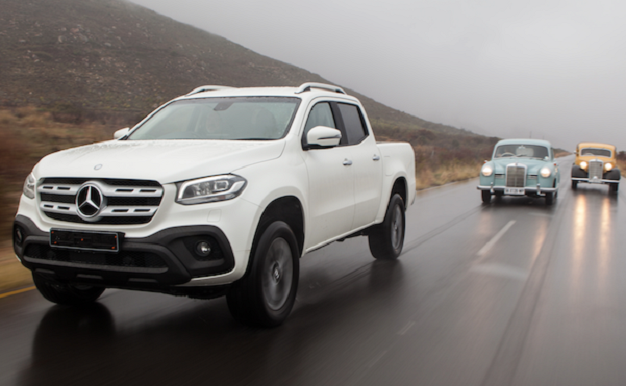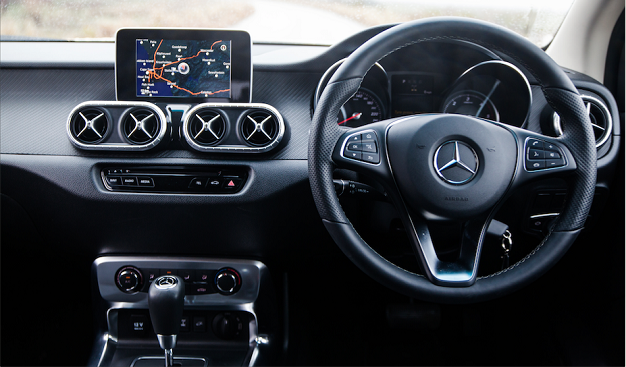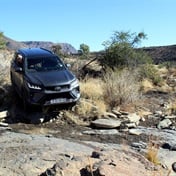
With the eagerly awaited Mercedes-Benz X-Class expected in South Africa next month, Ferdi de Vos and RoadTrip magazine gathered its unique locally assembled forebears for a wistful bakkie-trip through six decades…
Cape Town - The weather didn’t play along. Instead of the bright, sunny day, we hoped for, the Cape was misty, rainy and grey. Yet it created the right kind of ambience for the occasion – introducing the long-awaited new X-Class pickup from the stable of the Three-Pointed Star to its unique, locally assembled bakkie predecessors.
In the shrouds of mist they gathered, the dim light beams of the two old-timers eerily trying to pierce the foggy gloom, while the daytime LEDs of the newcomer effected a halo of light in the soft, persistent rain…
A halo model for Mercedes-Benz the new X-Class has become. Since Daimler in 2015 first announced plans to build a one-ton pickup, the world went crazy. Interest in this Benz bakkie was such that motoring websites crashed and social media platforms peaked.
Image: Ryan Abbott, Road Trip Magazine
X-Class again trended when the concept models were shown in Stockholm in October last year, and less than three weeks ago the same happened with the global unveiling of the production models right here in South Africa.
So, why all the hype?
Well, besides being the first bakkie model from Stuttgart in over sixty years, the X-Class is also the first modern one-ton pickup from a premium manufacturer – a class these companies have never really considered in recent times.
The first Benz bakkie
However, things were very different six decades ago. It was just after World War II and in Germany, pickups were needed to help to build up the devastated infrastructure of the country.
So, the first “bakkie” with a Merc badge was converted from the W136 170V sedan model. These vehicles, offered either with a flatbed or with a box-body on the back, was assembled in Germany from 1946 to 1949 and 1098 were built, mostly for government services.
Image: Ryan Abbott, Road Trip Magazine
This platform also served as the basis for vehicles converted in Argentina and South Africa, with small numbers exported to Australia, New Zealand and erstwhile South-West Africa (Namibia).
In Argentina, the W136 170D model was assembled from 1952 to 1955 in Mercedes-Benz’s San Martin facility, but it isn’t clear how many pickups were produced here.
In South Africa, the idea of producing a Mercedes pickup originated in the early 1950’s with the original six post-war independent Mercedes-Benz importers. At that time Cargo Motors in Johannesburg, NMI in Durban, Stanley Porter in Cape Town, Haaks Garage in Pretoria, Ronnie's Motors in East London and John Williams Motors in Bloemfontein were all selling Mercedes models and other German makes.
However, they were severely limited by the by the strict allocation of car import permits (for example, in 1955 they could only sell 100 cars) while bakkies, classified as commercial vehicles, were exempt from these strict regulations.
With the assistance of the engineer Heinz Grossman and Mercedes-Benz’s central office in Johannesburg, the importers concluded a deal with Daimler-Benz AG to, instead of fully built-up cars, import so-called “chassis-cabs” or "half-cars" –a built-up vehicle without the body section behind the B-pillar.
Image: Ryan Abbott, Road Trip Magazine
Built in SA; over 60 years ago
Initially, some 170V and SV’s were imported in this fashion (like “Vrekkie”, the immaculately restored 170Vwith a M136 1,697cc diesel engine delivering 28 kW and a four-speed synchromesh transmission used in our photoshoot), but soon the local importers decided to start importing the W120 Mercedes-Benz 180D Ponton.
This model, powered by the OM636 VII 1.767cc diesel engine delivering a still measly 29kW at 3,200 r/min and 101Nm of torque at 2,000 r/min, but the bakkie and its sedan counterparts proved very popular in South Africa.
Getting Stuttgart to authorise the import of the 180D half-cars initially proved difficult, but in the end, the bakkies were built here with the full blessing of Daimler-Benz AG.
Okay, they did not receive a specific model code, but the basic donor chassis was exported here specifically for a bakkie conversion; and while many ’Benz alterations were done over the years, the local conversions was one of a few with a sustained production run.
Image: Ryan Abbott, Road Trip Magazine
Getting approval was one thing; finding a local coachbuilder capable of building a quality load box was even more of a challenge. Eventually, the company Morewear Industries in Germiston fabricated the desired load-box, and the result was convincing – in terms of quality and design.
The first 180D Ponton bakkies went on sale in 1955. Besides being known as “bakkies”, they were also called “Stanley Porters” after the Cape Town Mercedes importer. While exact numbers are not known, about 400 were sold up to 1958.
Production of the bakkie ceased when Daimler-Benz, recognising the potential of the SA market, started assembling the 180-sedan locally in East London, thereby annulling the import quota restrictions.
Image: Ryan Abbott, Road Trip Magazine
German interest
However, the bakkie’s success did not go unnoticed in Germany. The coachbuilder Binz used its close ties to Mercedes to, in 1956, produce its own version of the pick-up.
There were some distinct differences between the local conversion and the Binz – the most prominent being the gap between the cabin and load-box of the South African version, while the Binz did not have it.
The original bakkie’s rear fender was part of the load box (a neat solution) while that of the Binz was unaltered, giving it a different look. The SA bakkie also had higher tail lights and a slightly longer cabin to accommodate the spare tyre behind the left seat, while the Binz cabin was shorter, with the spare tyre stored in a compartment under the tail.
It is estimated that Binz produced around 450 pickups, with some exported to South Africa. According to Daimler-Benz files, 2,439 of the 180D were produced from 1955 to 1962, and 136 of the 190D body type were apparently also converted.
By the end of the 1950’s around 550 Merc180D bakkies were on South African roads. Not many have survived and today both the 170V and 180D has great collectors value.
Image: Ryan Abbott, Road Trip Magazine
New era, new pickup
While there were some other private conversions of Mercedes-Benz cars to pickups, the only other “official” bakkie sanctioned by Stuttgart was “La Pickup” – a project from Mercedes-Benz in Argentina from 1971 and 1975, using a Santa Fe coachbuilder to convert W115 220D models to half-ton pickups, based on a Binz design.
It took nearly forty more years before the development of a new Benz bakkie was commissioned; and if it wasn’t for Daimler’s alliance with Nissan-Renault, established in 2010, it might’ve never happened…
Because, as is now well-known, the new X-Class is based on the underpinnings of the Nissan Navara; highlighted by a (very Nissan-looking) ignition key for the white X250d auto 4Matic right-hand drive model with Progressive specification we used in our photo-shoot – a vehicle essentially developed in Japan, and fine-tuned by designers and engineers in Europe to become a German premium product – the Mercedes-Benz of bakkies.
In terms of styling and dimensions, there are some clear differences between the X-Class and the Navara. Compared to the Nissan with its stretched grille and sweptback headlights, the Merc shares its frontal design with its SUV compatriots. right down to the deep-set headlights, big badge and aggressive twin-louvre grille. But the lower valance is unique to the bakkie.
Squarer wheel-arches on the X-Class is another variation but seen in profile, they look much the same. At the rear, the Merc’s slimmer taillights is noticeable, and it also lacks the character line on the tailgate of the Navara.
Longer, wider
Both have a wheelbase of 3,150 mm, but the German is 85 mm longer and 70 mm wider than its Japanese donor – and this extra width, as well as its strong frontal design, gives the X-Class decidedly more road presence.
In the interior, there are some references to its origins, such as the gear-lever and some door panel components, but with cleverly integrated brand-specific equipment, such as the floating infotainment screen, round air-vents and a multifunction touchpad, Merc has transformed the cabin.
Within the limitations set by platform-sharing, the designers and engineers from Stuttgart has done an excellent job with the X-Class. It does raise the bar in terms of what is expected of a leisure bakkie.
It will clearly be a strong contender in the one-ton pickup market, with nary a buyer specifically waiting for the local launch of the Merc-badged competitor in May, and it will also lure people out of executive sedans and SUVs.
Yes, price may be a factor, but for those who always wanted the practicality of a double-cab, but one with a less harsh ride and the “right badge” on the bonnet, it will be a no-brainer.
Besides its obvious status appeal, it also has all the attributes to make it a versatile long-distance runner. Add to this its off-road capability, and the X-Class will be close to the ideal vehicle for an extended road trip…
*Our thanks to Waldo Scribante and Theo Claassen for making their pristine and invaluable vehicles available to us, as well as to Wayne Harley from the Franschhoek Motor Museum for the use of the premise.
Mercedes X-Class specifications
Specs: Mercedes-Benz X250d 4MATIC Progressive
Engine: 2,298cc, 4-cylinder, biturbo diesel
Power: 140kW @ 3,750r/min
Torque: 450Nm @ 1,500-2.500r/min
Transmission: 7-speed automatic
Drivetrain: Four-wheel drive (4Matic)
Suspension: Double wishbone (front), multi-link, coil, solid axle (rear)
Tyres: 255/60R18 (optional)
0-100 km/h: 11.1seconds
Top speed: 175km/h
Fuel consumption: 7.9 l/100km
CO2 emissions: 207 g/km
Price: R 723 810 (available from May 2018)
Mercedes-Benz 1956 pickup specifications
Specs: 1956 W120 Mercedes-Benz 180D bakkie
Engine: 1,697cc, 4-cylinder diesel
Power: 29kW @ 3,200r/min
Torque: 103Nm @ 2,000r/min
Transmission: 4-speed manual
Drivetrain: Rear-wheel drive
Top Speed: 116km/h
Mercedes-Benz 1949 pickup specifications
Specs: 1949 W136 Mercedes-Benz 170V bakkie
Engine: 1,797cc, 4-cylinder diesel
Power: 28kW @ 3,600r/min
Torque: 100Nm @ 1,800r/min
Transmission: 4-speed manual syncromesh
Drivetrain: Rear-wheel drive
Top Speed: 108km/h




 Publications
Publications
 Partners
Partners
















